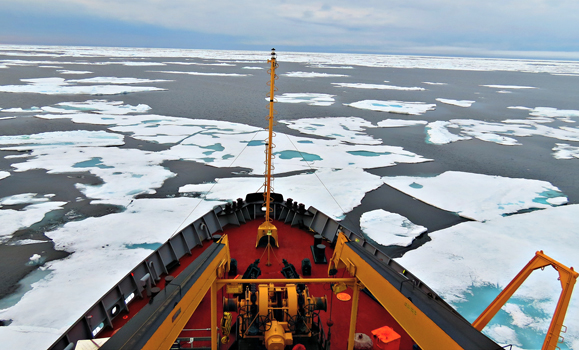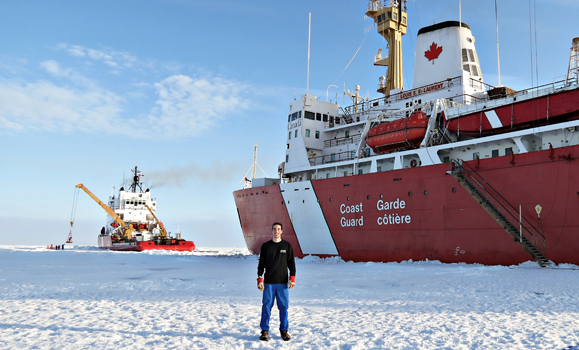Kai Boggild may chuckle at the idea of being a third-generation Arctic explorer, but the 21-year-old Īꔄtv co-op student recently became just that.
A double-major in Biology and Earth Sciences, Kai joined Natural Resources Canada for two work terms, where he helped with the mapping of marine geology in the Labrador Sea, the Grand Banks and the Scotian Margin. This learning experience took an epic turn when Kai’s co-op supervisor invited him to join a six-week expedition to the North Pole.
‚ÄúIt was hard to believe at first, but obviously I was very excited,‚ÄĚ Kai recalls. ‚ÄúThe North Pole is a destination that you never expect to go, so when an opportunity comes to go there and conduct science in the highest latitudes, it‚Äôs pretty stunning. I knew from the get-go that it would be an experience that I would remember for the rest of my life.‚ÄĚ
Kai joined a crew of sailors and researchers aboard the 120-metre Canadian Coast Guard Heavy Arctic Icebreaker Louis S. St-Laurent. The Louis was built for the rigours of Arctic ice and is a veteran of numerous expeditions since being launched in 1966.
‚ÄúMy supervisor talks about the Arctic as one of the last frontiers on earth, because it‚Äôs so unexplored,‚ÄĚ Kai says of David Mosher, chief scientist during the 2014 Arctic Expedition. ‚ÄúIt has traditionally been pretty inaccessible due to the ice. We were going places that hadn‚Äôt been surveyed before, and collecting data in places where it had never been collected.‚ÄĚ
Part of the Geological Survey of Canada, the 2014 Arctic Expedition focused on the Lomonosov Ridge, which runs across the Arctic Ocean, to detail the extent of Canada’s continental shelf. A better understanding of the ocean’s underwater geology allows Canada to uphold The United Nations Convention on the Law of the Sea (UNCLOS), which serves as guidelines for the marine economic rights of more than 80 countries.
Setting sail for the arctic
The fog lifted to form a clear, sunny day in St. John’s as the Louis left port to rendezvous with the CCGS Terry Fox. The Terry Fox was outward bound a day earlier, and would break ice ahead of the Louis, which contained the bulk of the research equipment, once they reached the Arctic Circle on day six.

Water and ice stretch into the horizon ahead of the Louis S. St-Laurent. (Photo: Kai Boggild) Őż
The temperature had dropped noticeably by that time and a lone iceberg heralded things to come. Soon, a steady drumming began as the first ice floes struck the steel hull. This intensified to a thunderous rumble as the ice pack thickened. The crew saw polar bears and entered a zone of perpetual sunset, with the sea ice beginning to take on interesting properties. Őż
Őż
‚ÄúYou had these pressure-ridges where ice floes were colliding and making big formations. You‚Äôd see them on top, but you‚Äôd also recognize that they‚Äôve got to be pretty big underneath.‚ÄĚ
To an Earth Sciences student, ice formations like these are akin to a miniature version of plate tectonics ‚ÄĒ the visible ice pressure ridges only hinted at the true scope of activity beneath the surface, with nine-tenths of the ice hidden from view.
Őż
On day 19, the Louis arrived at 90 degrees north, nearly 20 years after she became the first Canadian Ship to reach the pole. To celebrate the occasion, the crews of the Louis and the Terry Fox gathered on the ice for hockey, golf, music and what must have surely been among the most frigid of ALS ice bucket challenge entries.

The arctic icescape. (Photo: Kai Boggild)
The crew quickly returned to serious matters, collecting water column samples to determine plankton biodiversity, measure inorganic carbon, examine various isotope concentrations and track glacial melt runoff. Undiscovered geologic features were revealed, including a previously undetected knoll just east of the Lomonosov Ridge.
The extreme challenges of collecting subsurface data beneath thick Arctic ice are met by the Louis’ specialized arsenal of seismic equipment. Two air-compressors, each the size of a small SUV, power a trio of heavy airguns towed 12 metres beneath the surface ice. Each airgun produces an acoustic pulse, which bounce off the seafloor and are recorded by a 200m hydrophone streamer, providing a high-resolution 2D cross-section of the underwater landscape.
‚ÄúFor scientists, discovering the geology of the seafloor and what‚Äôs beneath helps solve the puzzle of what is otherwise pretty uncharted territory.‚ÄĚ Kai explains. ‚ÄúThese kinds of discoveries are exciting and are a big reason why research in this part of the world is so rewarding. It‚Äôs very much exploratory science.‚ÄĚ
From the classroom to the arctic
Not only did Kai join an elite group of people who have made it to the North Pole, but he’s followed in the footsteps of his father and grandfather before him.
‚ÄúMy dad was a writer on the 2011 expedition to the Arctic with an earlier Geological Survey of Canada UNCLOS expedition. My grandfather was a naval captain during the Second World War, and after the war, spent time aboard an RCMP ship doing mapping and taking soundings throughout the Northwest Passage and the Amundsen Gulf. The Arctic is [mostly] unexplored now, but back then, there was more ice, and it was even more unexplored. I kind of got an idea of where he was at.‚ÄĚ

Kai stands next to the Louis St-Laurent on the Arctic ice pack. In the background, the Terry Fox offloads crew using a crane. (Photo: G. Williams )
Kai’s coursework at Dal helped to prepare him for the expedition, exposing him to geophysics, reflection seismology and more of the kind of science used during the arctic survey. Academics have already taken Kai to interesting places, including tropical Trinidad and Tobago during his Petroleum Field Methods, and the Southwestern United States during his Advanced Field School. In addition to learning on the job, Kai returned to his classes with an enriched understanding gained through hands-on experience in co-op.
‚ÄúThis job definitely built upon my skills as a geoscience student. It‚Äôs pretty cutting-edge research to be a part of, and to be able to learn about a virtually untouched part of the world in the geological sense was an incredible way to apply the lessons I learned along the way. Co-op has given me experience that‚Äôs related to what I‚Äôm studying, which is super valuable. I really couldn‚Äôt think of a better experience.‚ÄĚ
.

Kai reviews seismic data collected aboard the Louis S. St-Laurent. (Photo: D Reimer)

